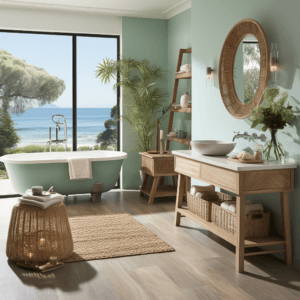Choosing the right tiles for a kitchen renovation can be a daunting task, given the variety of options available in the UK market. This guide aims to help UK consumers navigate this process, considering everything from kitchen styles, tile materials and sizes, to more nuanced factors like lighting and kitchen functionality.
Kitchen Styles and Their Influence on Tile Selection
Kitchen style plays a significant role in tile selection. For modern kitchens, sleek tiles with minimalistic designs, often in neutral colours, are popular. These could be large format tiles which provide a seamless look.
Rustic or farmhouse-style kitchens, on the other hand, often incorporate natural stone or terracotta tiles, which add to the warm, homely feel characteristic of this style.
Traditional kitchens might opt for classic white ceramic tiles for a timeless appeal, often embellished with patterns or accents for visual interest.

Different Areas for Tiling: Floor, Walls, or Both
Where you plan to install the tiles also influences your choice. Floor tiles need to be durable to withstand high foot traffic, resistant to spills and easy to clean. Porcelain tiles are a popular choice due to their durability and wide range of designs.
Wall tiles, particularly those for a backsplash, need to be resistant to heat and easy to clean. Glass or ceramic tiles are commonly used for their ease of maintenance and versatility in design.
For kitchens where both walls and floors are tiled, it’s important to ensure that your choices complement each other. You could opt for the same tiles for a uniform look, or mix and match while maintaining a cohesive colour scheme.

Tile Materials and Sizes: Perception and Practicality
The choice of tile material and size can have a big impact on the overall look and feel of your kitchen. Ceramic and porcelain tiles are popular due to their durability, affordability, and variety of designs. For a more luxurious touch, you might opt for natural stone or glass tiles.
The size of your tiles can influence the perception of space in your kitchen. Large-format tiles can make a small kitchen appear larger, while smaller tiles or mosaic designs can add detail and interest to a large space. Remember, larger tiles require fewer grout lines, leading to a cleaner aesthetic, but they might not fit well in small or unusually shaped areas.

Influence of Lighting on Tile Choice
Lighting, both natural and artificial, can significantly affect the appearance of your tiles. Light-coloured tiles can help brighten a kitchen with limited natural light, while darker tiles can add depth and warmth to a well-lit space. Glossy tiles reflect light and can make a space feel brighter and larger, but they might show up dirt and scratches more easily than matte tiles.

Role of Kitchen Functionality in Tile Choice
The functionality of your kitchen should also influence your tile selection. High traffic areas, such as in front of the sink or cooker, require durable and slip-resistant floor tiles. Similarly, backsplash areas need heat-resistant, easy-to-clean tiles.

Factors Influencing Tile Choice: Size, Durability, Maintenance, Budget, and Trends
Several factors should guide your tile choice. The size of your kitchen can influence tile size and colour. Smaller kitchens might benefit from light-coloured, large-format tiles to create the illusion of space.
Durability and maintenance are crucial considerations—porcelain tiles are durable and require little maintenance, making them a popular choice. However, natural stone tiles, while beautiful and unique, require sealing and more careful cleaning.
Your budget will also be a significant determinant—ceramic and porcelain tiles offer a balance of affordability and durability, while materials like natural stone or glass can be more expensive.
Lastly, while it’s essential to choose a tile that you love, being aware of trends can help future-proof your kitchen design. For instance, the trend towards eco-friendly materials has seen a rise in the popularity of recycled glass tiles.

Balancing Aesthetics and Practicality
When choosing kitchen tiles, it’s crucial to balance aesthetics with practicality. While a particular tile might catch your eye due to its colour, pattern, or texture, it’s essential to consider its practicality. For instance, light-coloured tiles might show dirt and stains more readily, and glossy tiles, while visually appealing, may require more frequent cleaning.
Consider your lifestyle and how you use your kitchen. If you cook frequently, easy-to-clean, heat and stain-resistant tiles would be ideal for the backsplash. For families with children or pets, slip-resistant floor tiles would be a safer choice.
Remember, the most beautiful tile might not be the most practical. It’s about finding a balance that works for your lifestyle.
Common Mistakes in Choosing Kitchen Tiles
- Not considering the entire space: It’s essential to consider how your new tiles will fit into your kitchen as a whole. Will they complement your cabinets, countertops, and appliances? It’s advisable to take samples home and view them in your kitchen’s lighting.
- Ignoring maintenance requirements: While natural stone tiles might look attractive, they often require more maintenance than ceramic or porcelain tiles. Be sure to understand the maintenance requirements before making your choice.
- Choosing based solely on trends: While it’s great to have a modern-looking kitchen, choosing tiles based purely on current trends could date your kitchen quickly. It’s better to choose a design that you love and that will stand the test of time.
- Not ordering enough tiles: Always order about 10% more tiles than you think you need. This allows for breakages, cuts, and future replacements.
Conclusion
Choosing the right tiles for your kitchen is a blend of style and practicality. By considering your kitchen’s style, the tile’s material and size, the impact of lighting, the functionality of your kitchen, and factors such as durability, maintenance, and budget, you can make an informed choice. Avoid common mistakes and remember that while current trends can guide you, your personal preference should be the deciding factor. After all, you’ll be using your kitchen every day – so it’s important that you love the space.







